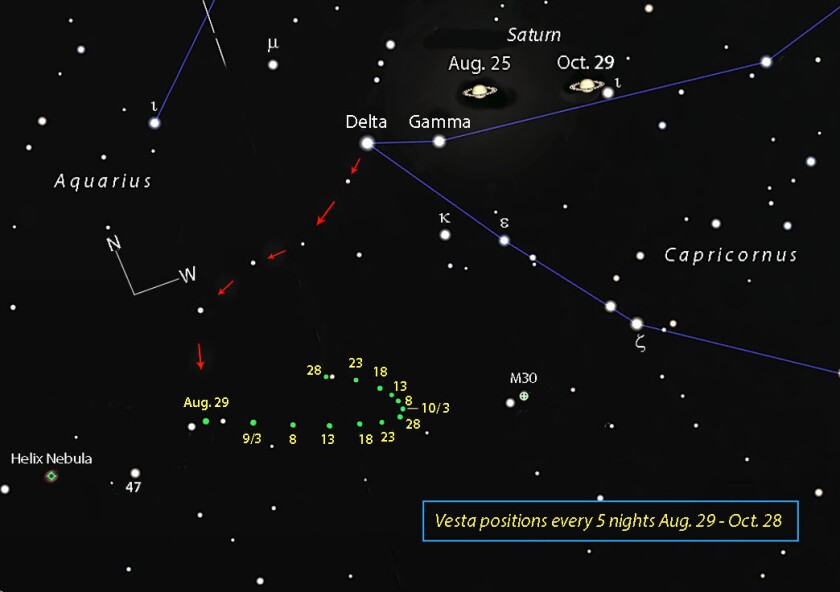I really enjoy Vesta because it's so bright. From really dark skies you can spot the asteroid without optical aid when it's nearest the Earth. Anywhere else, it's easy in binoculars. And while it looks just like a star in even a large telescope, it's a blast to watch Vesta crawl across the sky. Stars move, too. But they're all so far away we can only detect their motion with the unaided eye after thousands of years have passed. Asteroids are tethered to the sun as surely as the planets planets and shift against the background stars from night to night.

Earth and Vesta were closest on Aug. 17 at 119.2 million miles (191.8 million km) apart and reached opposition just five nights later. Opposition occurs when two planets — or an asteroid and a planet — line up alongside one another on the same side of the sun. That's also when they're closest for the year. Vesta's brightness varies depending on its distance from Earth. At peak luster on the 17th, it shone at magnitude 5.8. Now, two weeks later, it remains bright at magnitude 6.
German astronomer Heinrich Olbers discovered Vesta from his home observatory in March 1807 just five years after his asteroid first find, Pallas. As a gesture of appreciation to Carl Friedrich Gauss, the German mathematician who worked out the orbit of Ceres, Olbers asked Gauss to name his new find. Gauss chose Vesta after the Roman goddess of hearth and home.

You can warm your hands at Vesta's hearth by first finding Saturn, which climbs to a good altitude in the southeastern sky around 10:30 p.m. local time in late August (9:30 p.m. by mid-September). Point the binoculars at the ringed planet and "step" your way to the asteroid by using the stars as stepping stones. In the map above, I've marked one possible path but feel free to connect the dots in your own way. That's part of the joy of discovery of finding things in the night sky.

Planets and many asteroids, including Vesta, move around the sun in the same direction — from west to east as seen from Earth. Vesta is headed west at the moment because the Earth is passing it. Remember, we travel faster because our planet is closer to the sun than the asteroid.
ADVERTISEMENT
Around opposition, Earth laps Vesta. For a time, it appears to move backwards the same way a slower car appears to move backwards when you pass it on the freeway. The car didn't suddenly switch directions; it only appears that way because we're driving the faster car.
Likewise, slower Vesta appears to move backward or in retrograde as we pass it. By October, when we're well beyond the asteroid, it will resume its normal or prograde motion to the east. The same thing happens when the Earth laps Mars, Jupiter, Saturn and so on.
Why look at Vesta? First, it's just plain cool to see an asteroid and watch it move. Although nearly a million of these rocky bodies have been observed and cataloged, few are bright enough to see so easily in binoculars. You owe it to yourself to get acquainted with a class of objects you've often read about but perhaps have never seen with your own eyes.
Vesta is special in another way, too. It's the only known rocky protoplanet . In the distant past it was hot enough to melt and form a metal-rich core and rocky mantle, similar to Earth and the other terrestrial planets. At one time the Vesta was nearly spherical, but two massive impacts removed so much material from its south polar region that it's now shaped more like a potato. Some of that material landed (and continues to land!) on Earth as meteorites.
To learn more about Vesta and peruse an awesome collection of close-up photos taken by NASA's Dawn spacecraft during its 14-month-long mission there in 2011-12, go to photojournal.jpl.nasa.gov/target/vesta?sort=ASC.












